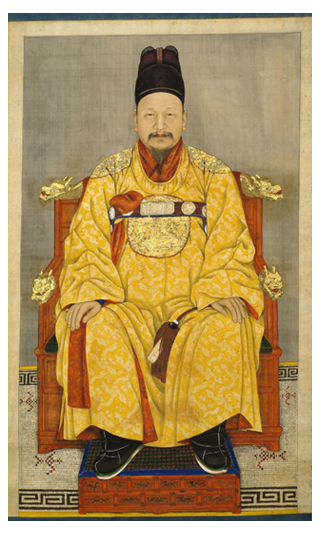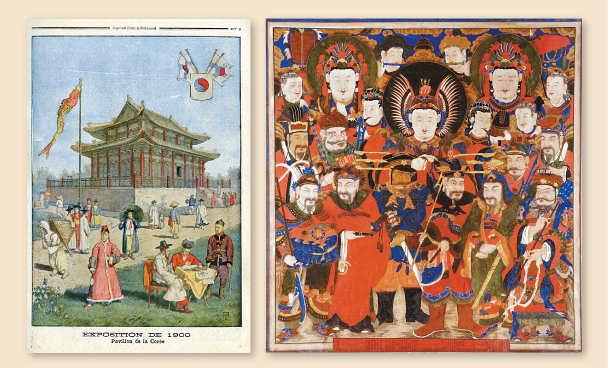Colorful expressions of Korea’s lost empire: Emperor Gojong was open to allowing art to show foreign influence

“Cranes and Peaches” (1902), a grand 12-panel folding screen, is on display at the National Museum of Modern and Contemporary Art Deoksugung in central Seoul for the “Art of the Korean Empire: The Emergence of Modern Art” exhibition. [MMCA]

After proclaiming himself emperor, Gojong is featured in a royal portrait wearing a golden robe and a winged headpiece, symbolizing imperial status. The portrait was painted by Chae Yong-shin. [MMCA]
In other words, if it was all about shunning foreign influences before, Emperor Gojong had a vision to embrace foreign elements as a way to improve rather than replace the existing traditions of Korea. To give visitors a better understanding of this vision of Gojong, MMCA has organized an exhibition at MMCA Deoksugung in central Seoul, which recently celebrated its 20th anniversary. Titled “Art of the Korean Empire: The Emergence of Modern Art,” the exhibit attempts to comprehensively show various types of art - including painting, photography and handicrafts - from before, during and after the Korean Empire to show how the era was “unquestionably a formative time in art history, laying [the] foundation for Korean modern art.”
In the first section titled “Art of Empire,” visitors can witness the transformation of Gojong’s portrait painting as he proclaimed himself an emperor. Painted by Chae Yong-shin (1850-1941) in the early 20th century, the portrait depicts Gojong wearing a golden robe known as a hwangryongpo and a winged headpiece called ikseongwan, which symbolizes imperial status.
“The art of the Joseon royal court was inherently conservative,” explained Bae Won-jung, curator of the exhibit. “However, the proclamation had a major impact on the art of the royal court. To convey the newly elevated status, the attire and emblems depicted in royal portraits and documentary paintings of court ceremonies had to be updated.”
Moreover, since Emperor Gojong attempted to strengthen his imperial status amid the political turmoil of the Korean Empire, art of the royal court from this period was no longer regarded as simple decorations. According to Bae, more Western realism and Japanese decorativeness can be seen in royal court artworks from the Korean Empire, in accordance with Emperor Gojong’s emphasis on modernization.

A porcelain jar with a floral design imported from England to be used by the royal court around the end of 19th century. [MMCA]
“We can see that Buddhist painters during the Korean Empire also attempted to pursue innovation and depart from traditional ways of painting while reflecting their hopes that the modern military could protect the Korean Empire,” explained Bae.

Left: An image featuring the Korean pavilion at a 1900 Paris Expo printed in Le Petit Journal. Right: “Buddhist Deities” (1907), featuring a group of Buddhist guardian deities known as sinjung. [MMCA]
“The year 1902 was an important year for the Korean Empire,” said Bae, “It marked 40 years of the king’s reign, his 50th birthday and more.”
The work has been part of the collection of the Honolulu Museum of Art since 1927, after ending up in the hands of Yamanaka & Company, a Japanese antique dealer, like many other smuggled Korean cultural properties.
“The painting was exhibited 10 years ago at the National Museum of Korea and after this exhibition, the painting won’t leave the Honolulu Museum of Art for another decade or so,” said Bae.
BY YIM SEUNG-HYE [sharon@joongang.co.kr]
The exhibition kicked off at the MMCA Deoksugung on Nov. 15 and will run through to Feb. 6 next year. Tickets cost 3,000 won ($2.66) for adults. The museum is open everyday except Mondays from 10 a.m. to 7 p.m. The museum is open until 9 p.m. on Wednesdays and Saturdays. For more information, visit www.mmca.go.kr.










with the Korea JoongAng Daily
To write comments, please log in to one of the accounts.
Standards Board Policy (0/250자)